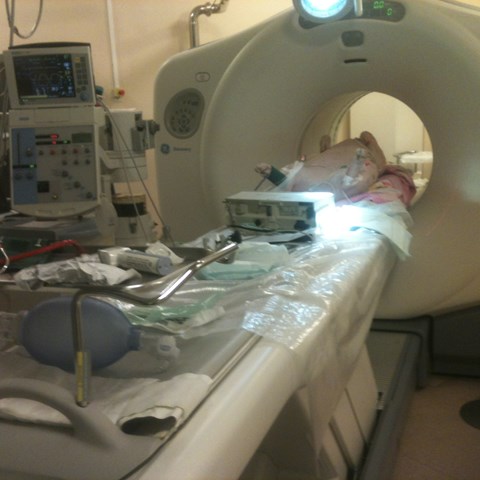Contact
Anneli Ryden
Lecturer at the Department of Clinical Sciences; Division of Veterinary Nursing
Telephone: 018-671890
E-mail: anneli.ryden@slu.se

Radiolabeled Exendin-4, a synthetic glucagon-like peptide-1 (GLP-1) analog, is used as a tracer for diagnostic purposes of β-cells and in experimental animal research.
Exendin-4 can be radiolabeled with 68Ga, 111In or 99mTc and used for positron emission tomography (PET) and single-photon emission computed tomography (SPECT) imaging to diagnose insulinomas, visualization of pancreatic β-cell mass and transplanted Islets of Langerhans. In humans, Exendin-4 is widely used as a therapeutic agent for treatment of type 2 diabetes (T2D). The compound, which is administered subcutaneously (SC) may cause nausea, vomiting and a minor increase in the heart rate (HR). However, possible side-effects on cardiovascular functions after intravenous (IV) administration have not been reported. This study describes the Exendin-4 dose at which cardiovascular side-effects occur in pigs and cynomolgus monkeys. The IV effect of the tracer on insulin secretion is also investigated in pigs.
Seven clinically healthy littermate pigs (40 days old) were used; three of them were made diabetic by streptozotocin (STZ). All pigs underwent PET imaging under general anesthesia to examine the glucagon-like peptide-1 receptor (GLP-1R) in β-cells with radiolabeled Exendin-4. A baseline tracer dose IV [68Ga]Exendin-4 (0.025 ± 0.010 μg/kg) followed by a competition dose IV [68Ga]Exendin-4 (3.98 ± 1.33 μg/kg) 60 min later were administered. Blood samples were taken and analyzed for insulin secretion by using ELISA. Cardiovascular and respiratory variables were monitored throughout the experiment.
Immediately after administration of the high dose [68Ga]Exendin-4 the HR rose from 122 ± 14 to 227 ± 40 bpm (p < 0.01) and from 100 ± 5 to 181 ± 13 bpm (p < 0.01) in healthy non-diabetic and diabetes-induced pigs, respectively. The tachycardia was observed for > 2 h and one healthy non-diabetic pig suffered cardiac arrest 3 h after the IV [68Ga]Exendin-4. Arrhythmia was detected by listening to the heart with a stethoscope up to 4 days after the [68Ga]Exendin-4 injection. In all animals, no effect on the cardiovascular system was registered after the low dose of IV [68Ga]Exendin-4. Insulin secretion increased (p < 0.05) when IV [68Ga]Exendin-4 was given in dosages ≥ 0.14 μg/kg.
Intravenous administration of ≥ 2.8 μg/kg [68Ga]Exendin-4 resulted in severe tachycardia and arrhythmias in healthy non-diabetic and diabetes-induced pigs, and the insulin secretion was stimulated in healthy non-diabetic animals when ≥ 0.14 μg/kg [68Ga]Exendin-4 was given.
http://www.sciencedirect.com/science/article/pii/S0969805115300676
Anneli Rydén, Görel Nyman, Lovisa Nalin, Susanne Andreasson, Olle Korsgren, Olof Eriksson, Marianne Jensen-Waern. Cardiovascular side-effects and insulin secretion after intravenous administration of radiolabeled Exendin-4 in pigs. Nuclear Medicine and Biology. Volume 43, Issue 7, July 2016, Pages 397–402.
Anneli Ryden
Lecturer at the Department of Clinical Sciences; Division of Veterinary Nursing
Telephone: 018-671890
E-mail: anneli.ryden@slu.se